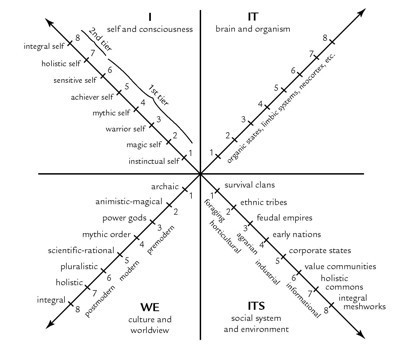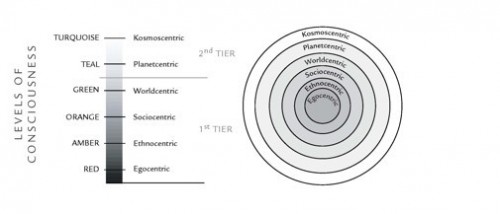All Levels: Depth and Complexity
Within each quadrant there are levels of development. Within the interior, Left-Hand quadrants there are levels of depth and within the exterior, Right-Hand quadrants there are levels of complexity . The levels within each quadrant are best understood as probability waves that represent the dynamic nature of reality and the ways different realities show up under certain conditions. Additionally, each quadrant’s levels are correlated with levels in the other quadrants. For example, a goal-driven executive (UL) who has high blood pressure (UR) will most likely be found in a scientific-rational culture or subculture (LL), which usually occurs in industrial corporate organizations (LR). In this example, all of these aspects of the situation are occurring at the same level of complexity and depth within their respective quadrant and are therefore correlated at level five in Figure 5. The inclusion of levels is important because they allow us to appreciate and better interface with the realities associated with each quadrant. Each quadrant serves as a map of different terrains of reality. The levels within each quadrant represent the topographical contour-lines of that terrain. This
helps us to identify the unique features of that particular landscape, which enables us to travel through it more successfully and enjoy the amazing vistas along the way.

Figure 5. Some levels in the four quadrants.
Levels or waves in each quadrant demonstrate holarchy, which is a kind of hierarchy wherein each new level transcends the limits of the previous levels but includes the essential aspects of those same levels. Thus, each wave inherits the wave of the past and adds a new level of organization or capacity. As a result, each level of complexity or depth is both a part of a larger structure and a whole structure in and of itself. In the subjective realm, sensations are transcended and included in impulses, which are transcended and included in emotions, which are transcended and included in symbols, which are transcended and included in concepts. Likewise, in the intersubjective realm this dynamic occurs from archaic interpretations to
magical explanations, to mythical stories, to rational views, to integral understandings. In the objective realm this movement occurs from atoms to molecules, to cells, to tissues, to organs. And in the interobjective realm this occurs in the movement from galaxies to planets, to ecosystems, to families, to villages (see Fig. 5 for another presentation of what is transcended and included in each quadrant). Regardless of where different researchers might draw the line between levels, a general pattern of evolution or development occurs in each quadrant: depth enfolds (i.e., folds in on itself), complexity increases (i.e., expands out and includes more).
Levels of development are often represented by arrows bisecting each quadrant (as in Fig. 5). Integral theory uses the notion of general altitude as a content-free way of comparing and contrasting development across different domains either within or between quadrants. This is akin to using a thermometer to gauge temperature in a variety of settings—a centigrade thermometer works at the equator just as well as in the arctic, and as a result allows us to compare the weather in those distant places in a meaningful way. Integral theory uses the colors of the rainbow to represent each distinct level (e.g., red, amber, orange, green, teal, turquoise). This spectrum of color also represents the general movement of a widening identity: from “me” (egocentric) to “my group” (ethnocentric) to “my country” (sociocentric) to “all of us” (worldcentric) to “all beings” (planetcentric) to finally “all of reality” (Kosmoscentric) (see Fig. 6). This general trajectory of expanding awareness has correlates in each quadrant. Integral theory also uses the image of concentric circles (often overlaid on the quadrants) to highlight the nested quality of levels transcending and including each other (see Fig. 6).

Figure 6. Widening identity (left) and the nested quality of levels as they transcend and include each other (right).
The inclusion of levels in an integral approach is valuable because it recognizes the many potential layers of development within any domain of reality. Practitioners gain valuable traction by aiming their efforts at the appropriate scale and thereby finding the key leverage point—like an acupuncturist hitting the right spot for optimal health and well-being. This conserves energy and resources and focuses efforts optimally. For example, imagine working with a group of teachers on developing a new mission statement for their educational program. Clearly, working with the realities of the LL quadrant will be paramount—articulating shared vision and meaning, exploring via dialogue various phrases that might be used in the document, and so on. But you are going to be more effective in facilitating this collaborative process if you have a sense of the levels of shared meaning that are operative in this group and what they are trying to communicate in their statement. Are they operating primarily out of modern values, postmodern values, or a combination of both? Knowing this will greatly inform your capacity to serve their effort. Thus, it often is not enough to just be aware of the quadrants—you must also work with the depth and complexity within each domain.
Just as we can locate each quadrant in our own awareness through the use of first-, second-, and third-person perspectives, so too can we locate levels of depth and complexity in our direct experience. To illustrate this, all you have to do is notice how you tend to go through your day with a predictable amount of depth and complexity. For example, on good days you feel more depth and can handle more complexity and on other days you seem to be tripping over everything (diminished capacity to handle complexity) and find yourself getting irritated at the smallest thing (diminished capacity to experience depth). Thus, you often go through your day primarily expressing one altitude or level more than others, although you
have a felt sense of what it is like to be “up leveling your game” (a level above) or “misfiring with each step” (a level below).



